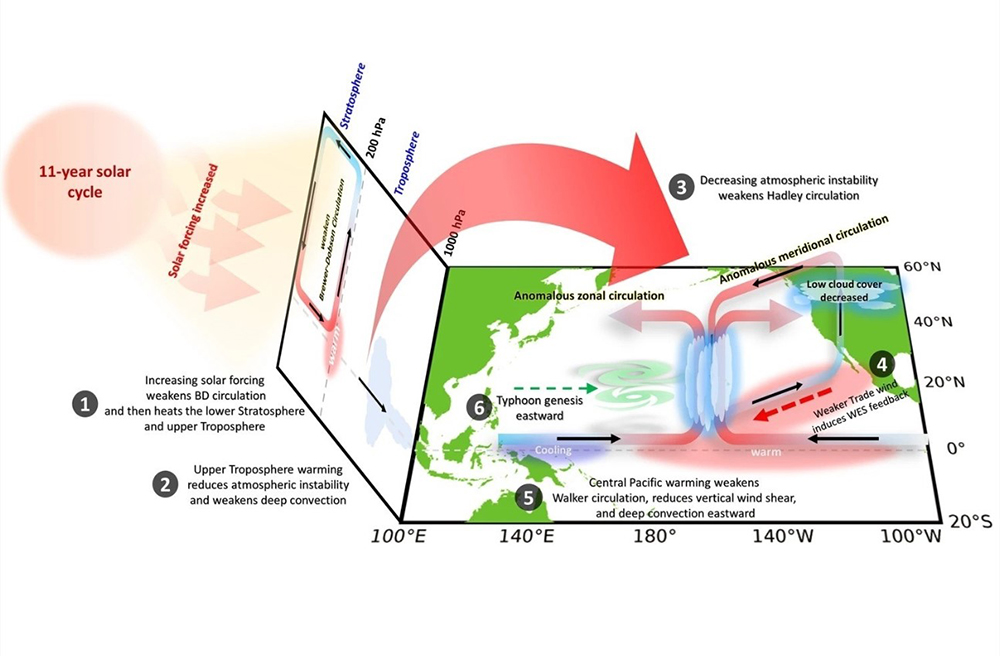


Key physical processes linking the 11-year solar cycle to off-season super typhoon activity in the North Pacific.
Taking the solar active period as an example, the following impacts occur:
(1) The increased solar forcing increases the latitudinal temperature gradient in the stratosphere, weakening the Brewer-Dobson circulation (BDC) and resulting in anomalous descending motions in the tropics that heat the lower stratosphere and upper troposphere.
(2) The upper tropospheric warming reduces tropospheric instability and weakens deep convection in the tropical Pacific, leading to a decrease in in-season (i.e., the May-through-October of the solar cycle year) typhoon activity.
(3) The weakened atmospheric instability also weakens the Hadley circulation in the Northern Hemisphere (which typically manifests during the boreal winter of the year).
(4) The change in the Hadley circulation strength results in a warm SST anomaly that extends from the Northeastern Pacific into the tropical central Pacific through the wind-evaporation-SST feedback.
(5) The resulting warm SSTs eventually arrive in the tropical central Pacific during the following boreal winter and spring seasons (i.e., November of the solar cycle year through the April of the next year) to weaken the Pacific Walker circulation, creating favorable atmospheric conditions for off-season (i.e., November of the solar cycle year through April of the next year) typhoons, including decreased vertical wind shear and increased positive low-level relative vorticity anomalies. (6) The resulting atmospheric conditions cause off-season typhoons to form further eastward than usual, move slower, and spend more time over the ocean, which increases the likelihood of super typhoons forming.
In the western North Pacific, typhoons typically occur from May to October, when atmospheric and oceanic conditions such as wind shear and sea surface temperatures (SSTs) are favorable for typhoon formation. However, Super typhoon Haiyan, which struck the Philippines and resulted in more than 6,000 deaths in 2013, occurred during the off-season (November–April).
The study, which was jointly conducted by Wu's team and a team led by Yu Jin-yi (余進義), professor of Earth System Science at the University of California, Irvine, collected tracking data for 402 off-season super typhoons in the western North Pacific from 1945 to 2018. The study was published in the 'npj Climate and Atmospheric Science' journal.
The results of our observational analyses and climate model experiments suggest that the 11-year solar cycle can modulate the occurrence of super typhoons over the western North Pacific during the typhoon off-season.
The study looked into the three enhancing conditions that cause off-season typhoons, the first being the solar cycle. Every 11 years, the sun's magnetic poles change their polarity, and the Earth gains more momentum, heating up the tropopause, which causes the Hadley Cell and northeast trade winds to weaken.
Secondly, he went on, atmospheric condition such as global warming strengthen the connection between subtropical and tropical zones, which increases the relationship between the solar cycle and the formation of typhoons.Thirdly, the ocean-atmosphere interaction heats up the Northeastern Pacific and that warmth reaches the central Pacific, which reduces the Walker circulation and results in deep ocean circulations moving east. Such interaction also weakens the vertical wind shear in a way that facilitates the formation of off-season typhoons.
As a result, these steps can explain why more off-season super typhoons occur during active periods of the solar cycle.
The study further shows that the modulation of off-season super typhoon occurrence by the solar cycle intensified after the 1990s.
As typhoons are formed further eastwards in the off-season and there is a lack of steer flow they move more slowly, which means more energy and water are absorbed from the ocean, increasing the probability a super typhoon will form.
The research team added that as the Earth faces an active solar period over the next two years, the likelihood of super typhoons occurring is greater and people should remain vigilant.
Key points
More information